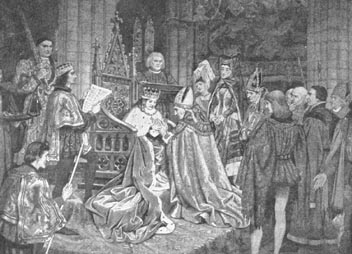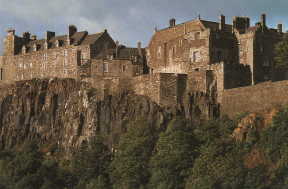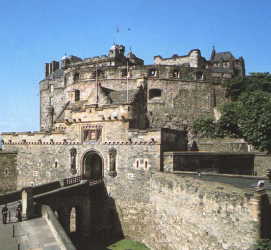 |
of the young King James II at Holyrood in 1437 |
Sir Alexander Livingston
The following account of Sir Alexander Livingston is copied from Sir Hector Livingston Duff, The Sewells of the New World, William Pollard and Co., 1924:
"Sir Alexander Livingston of Callendar, a man of transcendent ability and far-reaching ambition, left his mark deeply on the Scottish history of his time. He was the favourite counsellor of James I (of Scotland), after whose death he acted as guardian to the young King James II during his minority, and, in that capacity was for some time the virtual ruler of Scotland.
"Even in the turbulent age in which he lived, Sir Alexander Livingston was distinguished by his uncommon boldness and decision. These qualities are apparent in everything he did, but are nowhere more strikingly shown than in his high-handed interference with the re-marriage of the Queen Mother, Joan Beaufort grand-daughter of John of Gaunt and widow of James I. This singular affair and other violent passages in the life of Sir Alexander are very well described by Mr. E. B. Livingston in his Livingstons of Callendar, pp. 38-49.
"During his eventual career Sir Alexander
Livingston filled various offices of the highest dignity and importance,
including those of Justiciary of Scotland and Ambassador to England. He
died in 1451. By his wife, a daughter of James Dundas of Dundas he had,
among other children, two sons, of whom the younger, Alexander Livingston
of Feldes, Constable of Stirling Castle, was the ancestor of the Livingstons
of Dunipace (extinct 1678)."
 |
of the young King James II at Holyrood in 1437 |
Unfortunately for the memory of Sir
Alexander Livingston, no other source gives such a glowing account of his
life during this troubled time in the history of Scotland. Sir Alexander
Livingston, whose son Sir James Livingston (later 1st Lord Livingston of
Callendar) was Governor of Stirling Castle, was in a power struggle with
Sir William Crichton, Governor of Edinburgh Castle for control over King
James II who was in his minority. Originally James' mother, Queen
Joan Beaufort, was installed as co-Regent of the kingdom until the boy
came of age. She shared control with the Governor of Scotland, Archibald
Douglas, 5th Earl of Douglas, who, from motives which are unknown — probably
ill health was the reason — does not appear to have taken his duties very
seriously. The government of the country was much neglected by him,
and seems to have been carried on by whatever person happened to have custody
of the young king for the time being. It was around this time that Sir
William Crichton had control of James II, and Joan took her leave of Edinburgh
Castle after imploring Crichton to look after the boy. Unknown to
Crichton, she had concealed James in a large chest, and took him to Stirling
Castle and Sir Alexander Livingston. Before long, however, Joan decided
to return to Edinburgh and Crichton; with Livingston in hot pursuit.
The government of Scotland was truly in a shambles.
 |
 |
|
|
|
The inept Governor, Archibald Douglas, 5th Earl of Douglas, died on June 24, 1439, and Joan Beaufort married Sir James Stewart, the Black Knight of Lorn. Probably she wished to secure some male protector in these stormy times, when her son was so freely used as a pawn in the ever changing game of politics; but this knight adherred to the supporters of the House of Douglas, now led by the youthful William Douglas, 6th Earl of Douglas.
Sir Alexander Livingston undertook a very decisive series of actions. He had Sir James Stewart, the Black Knight of Lorn and his brother Sir William Stewart arrested and incarcerated at Stirling Castle. They were later released on finding security for their future good behaviour. On August 3, 1439 he arrested Joan Beaufort and had her confined to her apartments at Stirling Castle. Sir William Crichton felt neglected, so during Sir Alexander Livingston's absence from Stirling Castle, he found means to ambush James II in a park where the boy was accustomed to playing, and took him to Edinburgh Castle. Livingston then formed an alliance with Crichton, agreeing to give the latter a greater role in the governing of the country. Sir Alexander Livingston and Sir William Crichton then arranged to have the William Douglas, 6th Earl of Douglas and his only brother David Douglas executed at the infamous Black Dinner of 1440. The custody of James II remained in Sir Alexander Livingston's hands until he became Justicary of Scotland in 1444, when he transferred the guardianship to his eldest son Sir James Livingston, Governor of Stirling Castle. King James II began ruling Scotland in his own right about 1448, but it appears to have taken a few years to establish full control. In 1452, James personally stabbed and killed William Douglas, 8th Earl of Douglas who was plotting against him by entering into an alliance with the Lord of the Isles and the Earl of Crawford and negotiating with England.
It is difficult to form any conclusion as to what were the motives which influenced Sir Alexander Livingston in taking these high-handed proceedings. Some historians argue that it was solely to gratify his own selfish ambition for keeping the reins of government in his own hand which influenced Livingston. On the other hand, we must bear in mind that Sir Alexander Livingston was a man well advanced in years. He was in a position to remember the long regency of the Dukes of Albany during the minority of James I; and as a councillor of the late King James I, he understood the dangers the young James II would incur should he fall into the hands of a powerful noble such as the Earl of Douglas.
It is significant to note that when
James II came of age and proceeded to establish control over the nobles,
he apparently felt considerable attachment to his Livingston guardians.
While Livingstons, Douglases and others were arrested, charged with high
treason and executed, Sir Alexander Livingston and his son Sir James Livingston
were released after a very brief impisonment; the latter being raised by
James II to the peerage of Scotland as the 1st Lord Livingston of Callendar
in 1454.
Sir Alexander Livingston and Sir William Crichton, who had recently come to a power sharing agreement of sorts, were convinced that the Douglases, led by the young, headstrong 6th Earl of Douglas, were enemies of the throne. They felt it necessary to crush the Douglases to secure their own authority. Although it was fairly easy to secure sufficient evidence to support a charge of high treason against the 6th Earl of Douglas and his associates; it was an entirely different matter to arrest this powerful baron in the midst of his own people in his own castle.
It does not appear to have been difficult for Sir William Crichton to lure the young earl from his castle, and to convince him to present himself at the court of the boy king, James II in Edinburgh Castle for a celebratory dinner of reconciliation. Thus, the 6th Earl of Douglas, his brother David, and his advisor Sir Malcolm Fleming of Cumbernauld arrived at Edinburgh Castle on November 24, 1440.
According to legend, a banquet was held in the Great Hall of Edinburgh Castle, and the young James II was charmed with the company of the Douglases. At the end of the feast, the head of a black bull was brought into the hall. Under Scottish custom, this formality presaged the death of the principal guest(s) at a dinner. James II is alleged to have pleaded for the lives of his new friends to be spared, but they were said to have been beheaded in front of the ten year old king.
However, Mr. E.B. Livingston suggests a more likely scenario on pages 43 and 44 of The Livingstons of Callendar, Edinburgh University Press, 1920:
"But what we do know for certain is that on the arrival of the Earl of Douglas at the castle, he was at once arrrested, together with his only brother David, and his friend and consellor Sir Malcolm Fleming of Cumbernauld, who had accompanied him; that the three of them were hastily tried for high treason, found guilty, and proptly beheaded on the Castle Hill. The earl and his brother were executed on 24 November, 1440, and Sir Malcolm Fleming four days later. The later execution must have been carried out contrary to the wishes of Livingston, hence probably the four days' delay. For about three years later, on 16 August 1443, Sir Alexander Livingston, in the presence of Robert Fleming and four bishops, solemnly purged himself upon oath of having given any counsel, assistance, or consent to the slaughter of Sir Malcolm Fleming.
"Some of the old chronicle writers,
who like some modern journalists were not averse to inserting fictitious
picturesque details, so as to enliven their narratives, declare that the
Douglases were arrested while sitting at dinner, on the signal being given
by a black bull's head, supposed to be a sign of sudden death, being placed
on the table; and this fable, according to an old historian of the House
of Douglas, gave rise to the following doggerel rhyme:—
'Edinburgh castle, toun, and tower,
God grant ye sink for sin;
And that even for the black-dinner,
Earl Douglas gat therin.'
"It is, however, highly improbable that
either Livingston or Crichton would have been parties to the introduction
of such a theatrical dénouement into this ghastly tragedy . . .
."
Following the demise of William, 6th Earl of Douglas and his brother at the Black Dinner, William's great uncle James, known as "James the Gross" became the 7th Earl of Douglas. Apparently, he had connived at the execution of his nephew, and thus inherited the earldom and the Douglas Estates.
In another interesting development, Beatrice Fleming, the granddaughter of Sir Malcolm Fleming of Cumbernauld and daughter of Sir Robert Fleming, 1st Lord Fleming, married circa 1472 to Sir James Livingston, 3rd Lord Livingston of Callendar whose great grandfather, Sir Alexander Livingston, was deeply involved in the Black Dinner of 1440 that had resulted in the execution of Sir Malcom Fleming of Cumbernauld.
A Scottish History Site: Scotland's Kings and Queens
Click to return to the main Livingston of Callendar page.
Click to return to the Kings of Scotland page.